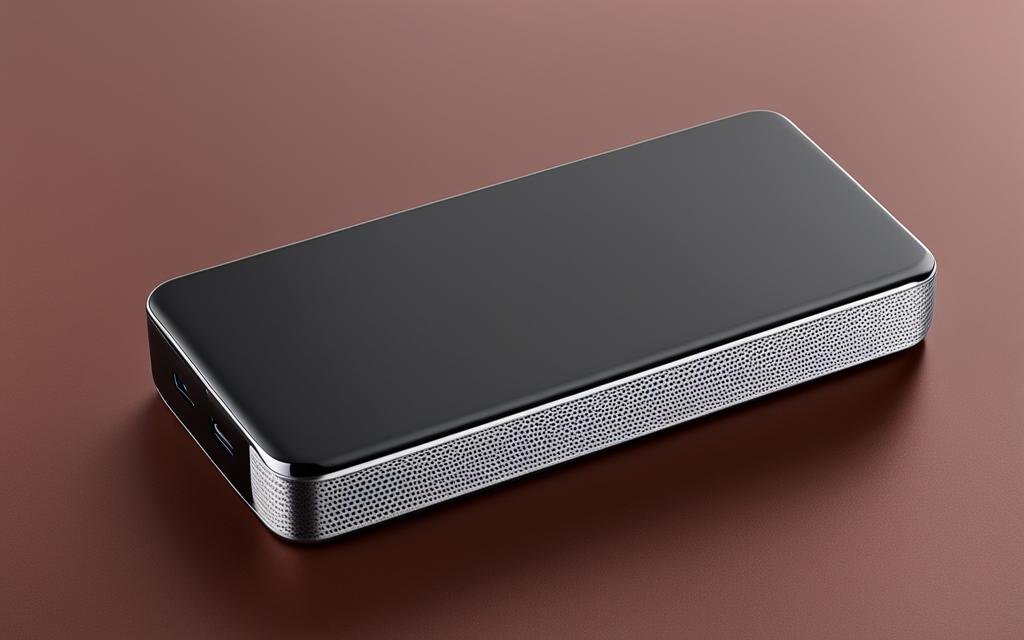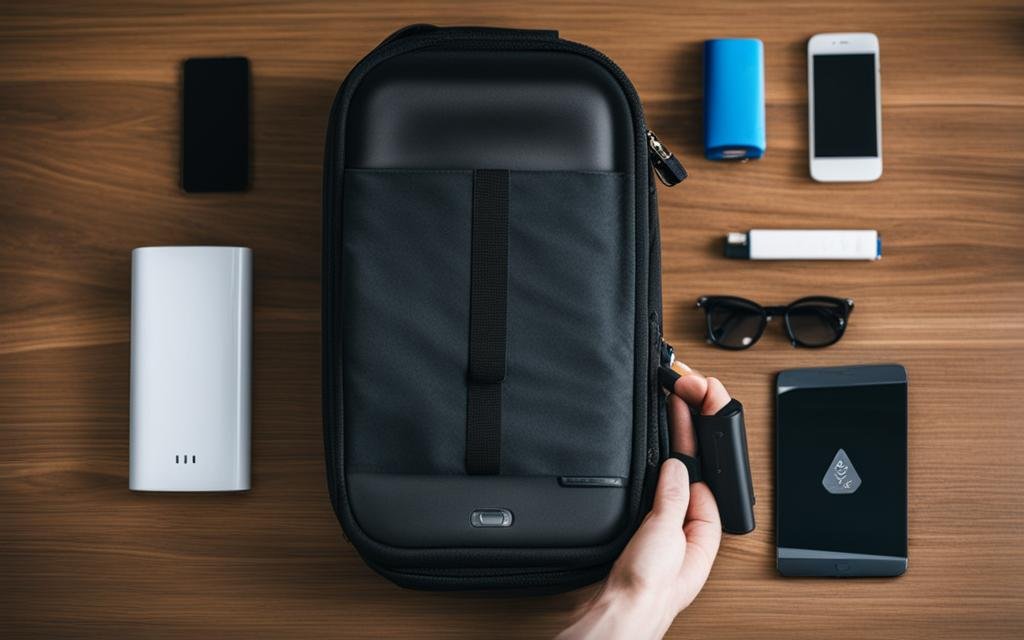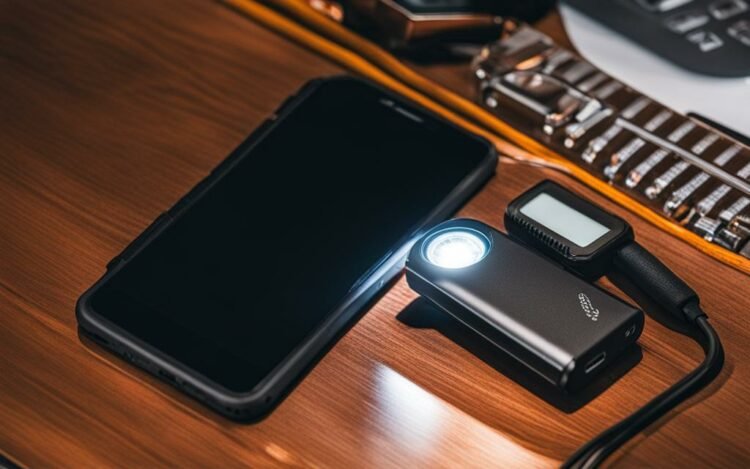If you’re like most people, you rely on your power bank to keep your devices charged on-the-go. But did you know there are important safety tips you need to follow to ensure your power bank doesn’t pose any risks to your gadgets or personal safety?
Using power banks correctly is crucial to their longevity and your overall charging experience. That’s why in this section, we’ve compiled essential power bank safety tips, charging tips, and maintenance tips to help you make the most of your power bank while keeping your devices and yourself safe.
Pro Tip: Don’t miss out on potential savings when buying a Power Bank. Take advantage of RAVPower coupon deals to maximize your budget and enjoy great discounts on your purchases.
Understanding Power Bank Basics
Power banks are portable chargers that can be used to charge electronic devices on the go. To ensure safe usage, it’s essential to follow power bank usage guidelines and take necessary power bank safety precautions.
Power Bank Usage Guidelines
- Before using your power bank, read the manual carefully to understand its specific usage instructions.
- Charge your power bank fully before using it for the first time.
- Do not leave your power bank in a hot or cold environment for an extended period.
- Avoid dropping your power bank or subjecting it to strong impacts.
- Use the appropriate charging cable for your device and ensure it’s compatible with your power bank.
Power Bank Safety Precautions
Using power banks comes with some safety risks, especially if they’re not used or stored correctly. Here are some power bank safety precautions to follow:
- Do not leave your power bank charging overnight or unattended.
- Keep your power bank away from sources of heat and water.
- Do not puncture or disassemble your power bank.
- Store your power bank away from children and pets.
- If you notice any damage or overheating, immediately stop using your power bank and contact the manufacturer for assistance.
By following these power bank usage guidelines and power bank safety precautions, you can ensure safe and efficient usage of your power bank.
Choosing the Right Power Bank
When it comes to selecting a power bank, there are important safety instructions to follow. Always choose a power bank from a reputable brand and make sure it has an adequate capacity for your device(s).
Additionally, it’s crucial to pay attention to the input and output specifications of the power bank. Make sure the power bank output is suitable for the device you are charging.
To ensure optimal performance and safety, it’s best to follow these best practices for power bank usage:
- Charge your power bank fully before the first use. This helps to condition the battery and improve the power bank’s overall performance.
- Avoid exposing your power bank to extreme temperatures. High temperatures can cause damage to the battery, while low temperatures can decrease the power bank’s capacity.
- Use the included cable or a cable from a reputable brand. Using a low-quality cable can damage the power bank or device being charged.
- Do not leave your power bank charging unattended. Overcharging can damage the battery and potentially lead to a safety hazard.
- Avoid dropping or puncturing your power bank. This can cause internal damage and potentially lead to a safety hazard.

Proper Usage and Charging
Using power banks safely is essential to extend the lifespan of your device and avoid any safety risks. Here are some guidelines to help you use your power bank properly:
Read the Instructions
Before using your power bank, read the instructions carefully. Familiarize yourself with the product and its features to ensure safe and efficient use. Follow the manufacturer’s guidelines to prevent any hazards.
Charge Your Power Bank
Make sure to charge your power bank fully before using it. Most power banks come with a charging cable, so use it to charge your device completely. Once the charging is done, unplug the power bank from the cable and store it in a cool and dry place.
Use the Right Cable
Using the correct cable while charging your power bank is vital to avoid any risks. Always use the cable provided by the manufacturer and avoid using a non-branded or damaged cable.
Avoid Overheating
Do not use or charge your power bank in high-temperature conditions, as it may overheat and cause harm. Keep the device away from direct sunlight or heat sources, such as a radiator or stove.
Don’t Overcharge/Overdischarge Your Power Bank
Do not charge your power bank for an extended period, or it may cause damage to the device. Similarly, do not let the power bank discharge completely before charging it again. Overcharging and over-discharging may affect the battery’s life and performance.
By following these usage guidelines, you can use your power bank safely and efficiently. Be sure to use your device with care, and always store and handle it responsibly.
Storing and Carrying Your Power Bank
Proper storage and transportation of your power bank are crucial to its longevity and can also prevent any potential safety risks. Here are some safety precautions and maintenance tips to keep in mind when storing and carrying your power bank.
Power Bank Safety Precautions for Storage
- Store your power bank in a cool, dry place away from direct sunlight and heat sources. Exposure to excessive heat can damage the battery and cause safety hazards.
- Avoid storing your power bank in a tightly enclosed space or container. Give it some space to breathe, as batteries can release small amounts of gas during charging and discharging.
- Do not puncture or damage the power bank’s outer casing, as it can lead to leakage, fire, or explosion risks.
- If you notice any physical damage to your power bank, such as cracks or dents, stop using it immediately and dispose of it properly according to local regulations.
Maintenance Tips for Your Power Bank
- Clean the power bank’s surface regularly with a damp cloth. Do not use harsh chemicals, as they can damage the casing or battery.
- Do not expose the power bank to water or other liquids, as it can cause a short circuit or damage the battery.
- Charge your power bank at least once every six months to prevent over-discharging and extend its battery life.
- If you plan to store your power bank for an extended period, ensure that it is charged to at least 50% to maintain its optimal condition.
By following these power bank safety precautions and maintenance tips, you can ensure the safe and efficient use of your power bank for years to come. Remember to routinely check your power bank for any physical damage or signs of malfunction, and dispose of it properly if necessary.

Troubleshooting Common Power Bank Issues
Despite taking all the necessary safety precautions and following maintenance tips, power bank issues may still arise. Here are some common problems you may encounter and how to resolve them:
1. Power Bank is Not Charging
If your power bank is not charging, make sure that it is turned on and that the cable is connected securely. Check if there is any debris or dirt in the charging port that may be blocking the connection. If all else fails, try using a different cable or charging adapter.
2. Overheating
If your power bank is overheating, unplug it immediately and let it cool down before using it again. Overheating can be caused by a variety of factors, including overcharging and exposure to heat sources. It’s important to use your power bank in a cool, well-ventilated area and avoid leaving it in direct sunlight or near heat sources.
3. Short Battery Life
If you’re experiencing a shorter battery life than usual, try charging your power bank fully and using it until it is completely drained before recharging. This can help recalibrate the battery and improve its overall performance. Additionally, avoid charging other devices while using the power bank as this can drain the battery faster.
4. Power Bank is Not Recognized by Your Device
If your device is not recognizing your power bank, check if the cable is securely connected and if the power bank is turned on. You can also try cleaning the charging port on both your device and the power bank with compressed air or a soft-bristled brush. If the problem persists, try using a different cable or charging adapter.
By following these maintenance tips and troubleshooting strategies, you can ensure the longevity of your power bank and avoid potential safety hazards. Remember to handle your power bank with care and always adhere to important safety precautions when using and storing it.
Conclusion
Congratulations! You now have a better understanding of power bank safety tips, usage guidelines, and maintenance best practices. By following these guidelines, you can ensure your power bank operates safely and efficiently for years to come.
Remember, always choose the right power bank for your needs, and follow safety precautions when using and charging it. Store and transport your power bank carefully, and troubleshoot any issues promptly to avoid further safety risks.
Lastly, we hope this article has been helpful in enhancing your overall charging experience. Feel free to share these power bank safety tips with others and help spread awareness about safe power bank usage.
FAQ
What are some power bank safety tips?
Here are some power bank safety tips to keep in mind:
– Use power banks that are certified and comply with safety standards.
– Avoid exposing power banks to extreme temperatures.
– Do not attempt to dismantle or repair a power bank yourself.
– Keep power banks away from water or other liquids.
– Do not charge your power bank overnight or leave it unattended while charging.
What are the basics of power bank usage?
When using power banks, it’s important to:
– Charge them using the provided cable and adapter.
– Avoid overcharging the power bank.
– Disconnect the power bank from devices once fully charged.
– Store power banks in a cool and dry place.
How do I choose the right power bank?
To choose the right power bank, consider:
– The capacity of the power bank, which should match your device’s battery capacity.
– The number of USB ports and the compatibility with your devices.
– The brand reputation and customer reviews.
What are some proper usage and charging techniques for power banks?
Proper usage and charging techniques include:
– Using the correct cables and adapters for charging.
– Avoiding exposing the power bank to high temperatures or direct sunlight.
– Charging the power bank fully before using it.
– Disconnecting the power bank from devices when not in use.
How should I store and carry my power bank?
To store and carry your power bank safely:
– Keep it in a cool and dry place, away from direct sunlight or heat sources.
– Avoid storing it in extreme temperature conditions.
– Use a protective case or pouch when carrying it in a bag or pocket.
How can I troubleshoot common power bank issues?
If you encounter common power bank issues, try the following:
– Ensure the power bank is fully charged.
– Use a different charging cable or adapter.
– Reset the power bank by pressing the reset button, if available.
– Contact the manufacturer or refer to the user manual for further troubleshooting steps.

